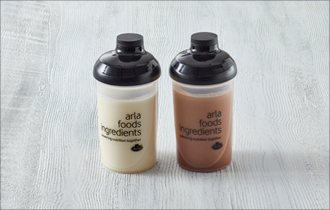Living longer
Deepening knowledge about health and disease coupled with advances in medical technology is helping people live longer than ever before. The ageing population is a global phenomenon, and in the Asia-Pacific (APAC) region, the number of people aged over 60 is climbing at an unprecedented rate.
By 2050, one in four people in the region is predicted to be over 60 years old, amounting to almost 1.3 billion people1.
Improve muscle health
Ageing brings with it many changes in health status, one of which is sarcopenia – a natural decline in skeletal muscle mass and function. Sarcopenia can have devastating effects on mobility, overall quality of life and life expectancy.
Fortunately, people can slow sarcopenia by consuming whey protein and exercising regularly.
In fact, three separate human clinical trials234 show that our hydrolysed whey ingredient, Lacprodan® HYDRO.Rebuild, can help counteract sarcopenia in resistance-trained elderly women.
The trials document significant health improvements in women consuming whey, including:
- Increased muscle mass
- Improved muscle strength
- Improved mobility
- Slimmer waist
- Reduced body fat
What makes whey so special? Whey protein is superior to other protein sources for muscle synthesis in the elderly567. This is due to its higher leucine content and fast absorption rate. Further, it provides all of the essential amino acids (EAAs) in a highly accessible form.
Quality over quantity
We’ve all heard the saying “quality over quantity” and this is certainly true with protein. Protein quality is measured using the digestible indispensable amino acid score (DIAAS), which reflects the amino acid content of a protein plus its bioavailability to humans. A score of one or above means that the dietary protein source supplies a highly available and digestible form of all the amino acids that are indispensable to the human body (the EAAs).
Protein quality can also be measured through the protein digestibility corrected amino acid score (PDCAAS). In this case, the highest possible score is 1.0. A protein source with a score of 1.0 offers 100 percent or more of the EAAs per unit of protein according to human requirements.
These scores indicate that whey delivers higher quality protein when compared with other common dietary protein sources.
Protein quality of common protein sources8

Be strong. Be healthy. Be active
Lacprodan® HYDRO.Rebuild offers the superiority of whey, along with the recognised benefits of hydrolysed whey protein. It is ideal for use in powder applications, making it possible to serve up fast-acting protein in a powder shake form for seniors who want to enjoy an active life for longer. The product is great-tasting, too!
Made in Denmark, this low-fat, 100 percent whey protein ingredient, Lacprodan® HYDRO.Rebuild, has a high content of EAAs and branched-chain amino acids (BCAAs). It is derived from grass-fed cows* and is Halal and Kosher.

Launching success
Health-conscious seniors living in the APAC region have a strong interest in functional foods and supplements as they aspire to lead longer, more healthier lives. In response, launches in senior nutrition products are on the rise9.
Launches of whey-based products targeted at seniors have increased dramatically in APAC countries (in 2015 there were 7 product launches; in 2019 there were 74). More specifically, supplemental milk powders in the adult nutrition sector make up 95 percent of new product launches.
While product launches are an indication of what consumers are demanding, it’s good to ask are these launched products actually being purchased? Recent figures show that the sales of nutrition and functional food products is steadily growing in China10. It is projected that the market will grow from 2,911 hundred million renminbi (RMB) in 2018 to 4,378 hundred million RMB in 2023.
Get in while it’s hot
With the ageing population in APAC countries set to skyrocket and a burgeoning number of whey protein product launches, a unique opportunity awaits you. You can be one of the first companies to offer a shake formulation that can help seniors live a strong, healthy and active life.
The formulation can also be supplemented with Capolac® – our natural milk mineral concentrate that supports bone health and promotes a healthy weight. Learn more here.
*
1. During periods of shortage of pasture growth and nutritional value of the grass, our farmers may give the animals foliage-based supplemental feed such as silage or hay.
2. The nutrition of our cows may also include the incidental feeding of grain, which may occur to ensure the animals’ well-being. Livestock may only be given feed that complies with the relevant legal requirements.
3. We believe that the above-mentioned points are fully consistent with the USDA definitions of Grass/Forage Fed.
- United Nations Population Fund, UNFPA (Asia & The Pacific)
- Junior PS, Ribeiro AS, Nabuco HCG, et al. Effects of Whey Protein Supplementation. Associated With Resistance Training on Muscular Strength, Hypertrophy and Muscle Quality in Pre-Conditioned Older Women. Int J Sport Nutr Exerc Metab. 2017;(January):1-27. doi:10.1123/ijsnem.2017-0253.
- Nabuco HCG, Tomeleri CM, Sugihara Junior P, et al. Effects of whey protein supplementation pre- or post-resistance training on muscle mass, muscular strength, and functional capacity in pre-conditioned older women: A randomized clinical trial. Nutrients. 2018;10(5):1-14. doi:10.3390/nu10050563.
- Silva AM, Barbosa DS, Fernandes RR, et al. Effects of Protein Intake Beyond Habitual. Intakes Associated With Resistance Training on Metabolic Syndrome- Related Parameters, Isokinetic Strength and Body Composition in Older Women. J Aging Phys Act. 2019:1-25. doi:10.1123/japa.2018-0370.
- Pennings B, Boirie Y, Senden JMG, Gijsen AP, Kuipers H, van Loon LJC. Whey protein stimulates postprandial muscle protein accretion more effectively than do casein and casein hydrolysate in older men. Am J Clin Nutr. 2011;93(5):997-1005. doi:10.3945/ajcn.110.008102
- Antonione R. et al. J. Nutr. 2008 138: 2212–2216
- Yang Y, Churchward-Venne T a, Burd N a, Breen L, Tarnopolsky M a, Phillips SM. Myofibrillar protein synthesis following ingestion of soy protein isolate at rest and after resistance exercise in elderly men. Nutr Metab (Lond). 2012;9(1):57. doi:10.1186/1743-7075-9-57
- Mathai JK, Liu Y, Stein HH. Values for digestible indispensable amino acid scores (DIAAS) for some dairy and plant proteins may better describe protein quality than values calculated using the concept for protein digestibility-corrected amino acid scores (PDCAAS). Br J Nutr. 2017;117(4):490-499. doi:10.1017/S0007114517000125. Rutherfurd SM, Fanning AC, Miller BJ, Moughan PJ. Protein Digestibility-Corrected Amino Acid Scores and Digestible Indispensable Amino Acid Scores Differentially Describe Protein Quality in Growing Male Rats. J Nutr. 2015;145(2):372-379. doi:10.3945/jn.114.195438. Bindari YR, Lærke HN, Nørgaard JV. Standardized ileal digestibility and digestible indispensable amino acid score of porcine and bovine hydrolyzates in pigs. J Sci Food Agric. 2018;98(6):2131-2137. doi:10.1002/jsfa.8697
- Innova Market Insights
- QianZhan Industry Research Institute, China





